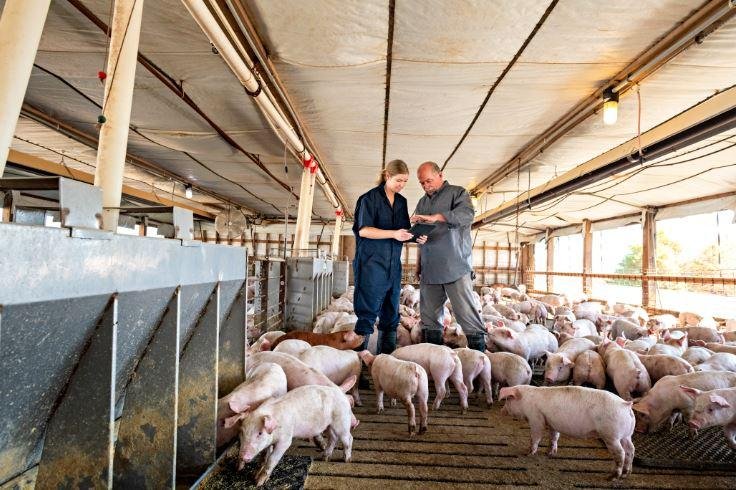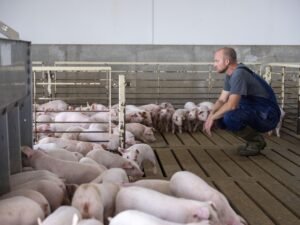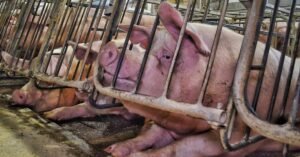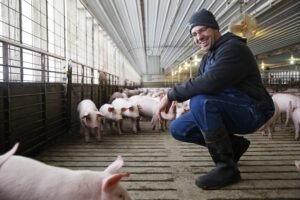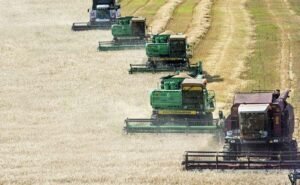Iowa’s pork industry in 2024 served as both an economic driver and a linchpin for communities scattered across the state—a reality confirmed by $15.4 billion in value added to Iowa’s economy last year. This impact didn’t arise overnight; rather, it has gradually evolved through a latticework of over 5,100 pig farms (to be precise: 5,172). Each of these operations plays its part in job creation, often subtly shaping rural landscapes and workforce stability.
With Iowa commanding roughly one-third—approximately 33%—of the nation’s hog inventory, the Hawkeye State continues its reign as America’s top pork producer. The farms collectively supported nearly an improbable-sounding number: more than 120,000 jobs statewide. A closer look reveals occupational diversity: about 64,000 jobs come from primary hog production roles; slaughter activities contribute another round thirty-nine thousand positions; meanwhile processing generates upward of sixteen thousand livelihoods.
Household income generated stands at around $8 billion—spread unevenly but still buoying counties whose other major industries can at times seem fragile or unpredictable. Somewhat paradoxically, despite this massive sum circulating throughout local economies in payroll and spending power each year, commodity producers have continued to face challenges reminiscent of farming unpredictability seen elsewhere: fluctuating input costs or export market volatility threaten even stable-seeming years.
Looking beneath top-line numbers reveals sectorial variation that colors the aggregate economic effect:
– Hog Production itself accounts for around $9.9 billion.
– Slaughter activity brings approximately $3.9 billion.
– Processing—including further value-added meat fabrication—generated an additional $1.5 billion during the same window.
Taxes paid into public coffers owing to this cluster totaled well beyond two and a half billion dollars ($2.7B), funding everything from rural infrastructure projects to education enhancements in smaller communities where pig operations frequently anchor civic life even if municipal borders are shrinking due to out-migration trends noticeable elsewhere.
The significance is not merely numerical—the regional impact ripples outward until nearly every county feels some facet of benefit (or occasionally burden) associated with large-scale animal agriculture. Expert stakeholders describe pork production as “the backbone” not just economically but also culturally; indeed certain town fairs would scarcely feel right without their signature barbecues echoing Iowa’s status on menus nationwide.
Distinctive features set the Iowa sector apart: higher concentrations of finishing barns interspersed among row-crop acres means producers can often capture efficiencies rooted in locally-grown corn and soybean feedstuffs—a synergy rare outside Midwest territories dominated by monoculture cultivation patterns prior decades saw intensify further still after trailing years’ consolidation cycles shaped farm demography anew.
Notably important but sometimes undervalued is risk borne by independent farmers who contract grower pigs under fluctuating integrator agreements—in contrast corporate-owned sites do offer operational resilience yet may reduce opportunities for smaller operators scrambling amidst shifting margins when disease outbreaks or international trade policy turns abruptly adverse (one puzzling feature given steady growth trends).
Simultaneously notable is ongoing investment into biosecurity protocols prompted by lessons learned abroad from African swine fever incursions or domestic flare-ups such as porcine epidemic diarrhea virus limiting interstate shipments previously anticipated with less paperwork Back ten-or-so years ago many believed regulatory flexibility would only increase efficiency while actually concerns today suggest stricter traceability requirements protect collective reputations more than they hinder day-to-day throughput speeds on most modern facilities.
In terms of environmental stewardship—a concern both praised and periodically scrutinized—Iowa’s industry pivoted toward improved manure management technologies including anaerobic digesters which convert waste into renewable natural gas streams utilized offsite by municipal partners desperate for carbon credits sometimes exceeding their city spending plans focused originally on roads alone rather than climate initiatives tied so directly now back to livestock innovation ecosystems rising here faster than pessimists predicted three crop rotations ago (the detail escapes some press releases).
While these advances secure sustainability points—and possibly global leadership credentials—they intersect societal debates over odor management practices near growing towns whose expanded suburbs recently replaced cropland once thought untouchable within living memory for many longtime residents skeptical about housing developments reducing land available for additional confinement sheds nearby—they remember colder winters somehow differently even though meteorological records indicate gradual warming since recordkeeping began before widespread antibiotic use became controversial topic among activist coalitions springing up alongside digital media platforms revolutionizing advocacy rarely seen so viscerally pre-internet era agriculture coverage never quite matched since early radio broadcasts covered record harvests sixty-three years ago unless you count last year which was drier overall except August surprisingly enough set new precipitation averages across three southern districts unexpectedly chart-topping according to extension agents’ monthly reports no casual outsider ever really reads anyhow because who could imagine something like that happening again so soon?
Nevertheless—the aggregate momentum behind pork remains undeniable heading into mid-decade forecasts predicting continued output gains so long as feedstock pricing remains competitive relative other commodities vying acreage allocations amid climate adaptive experimental varieties perhaps debuting en masse before decade closes whether policymakers embrace broader conservation incentives or cling tightly instead”to status quo frameworks beloved locally but prone eventual revision,” experts say wistfully at least twice per symposium lately convened anywhere near Iowa City hotels sufficiently large housing all delegates comfortably after hours spent debating details invisible beyond spreadsheet margins where real-world lives quietly depend daily upon outcomes largely taken for granted outside Heartland strongholds driving national food security quietly forward regardless producers’ persistent penchant toward cautious optimism leavened with hard-won realism no mere statistician could ever quite compute satisfactorily overnight—all things considered it certainly appears they’re nowhere close discouraged yet regarding what tomorrow brings next seasonal cycle finds fields green again regardless winter snows preceding them eventually melt away just like always before every spring planting commences anew though nobody keeps track exactly how often that actually happens nowadays without looking up weather logs first round each April anyway!

